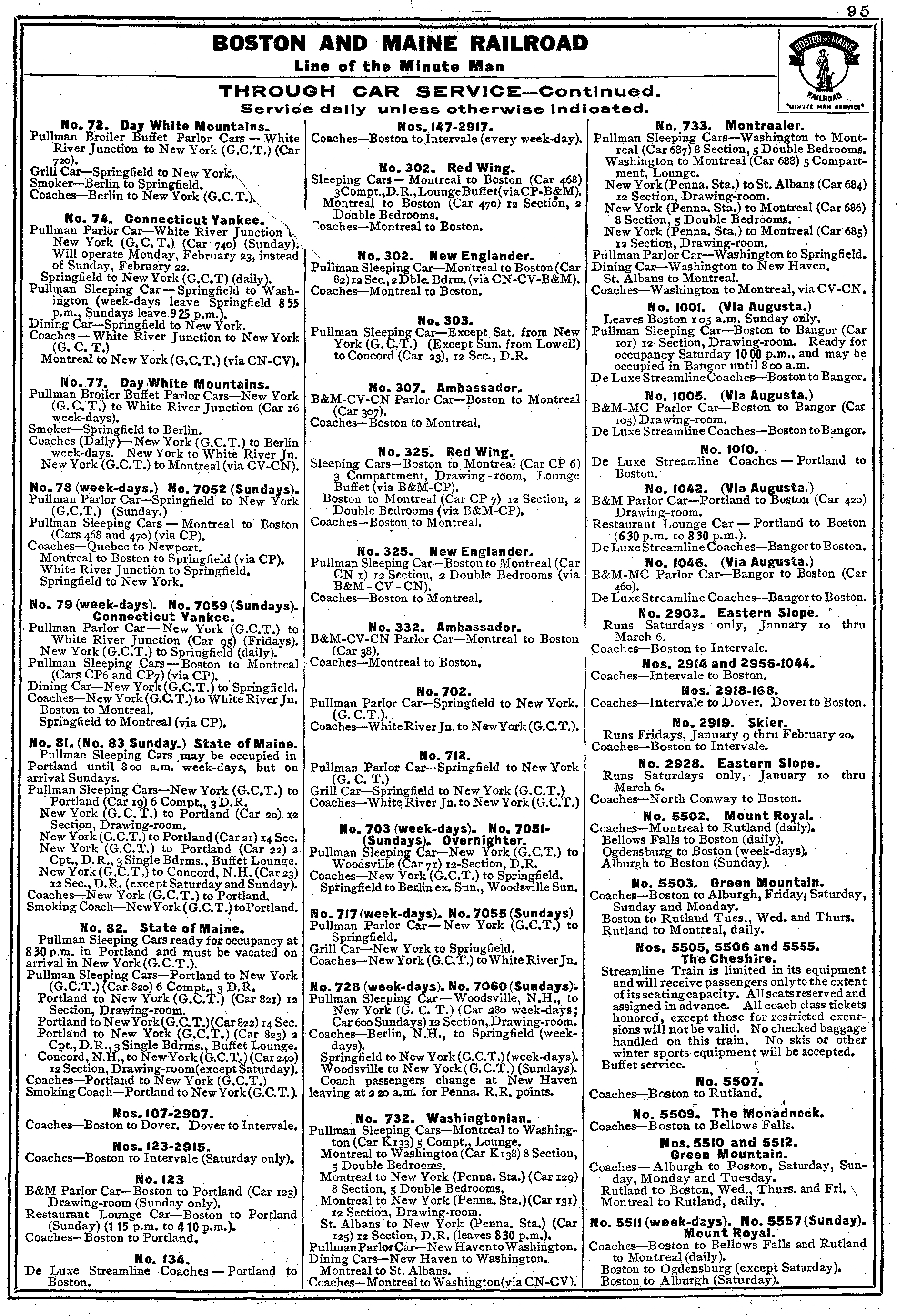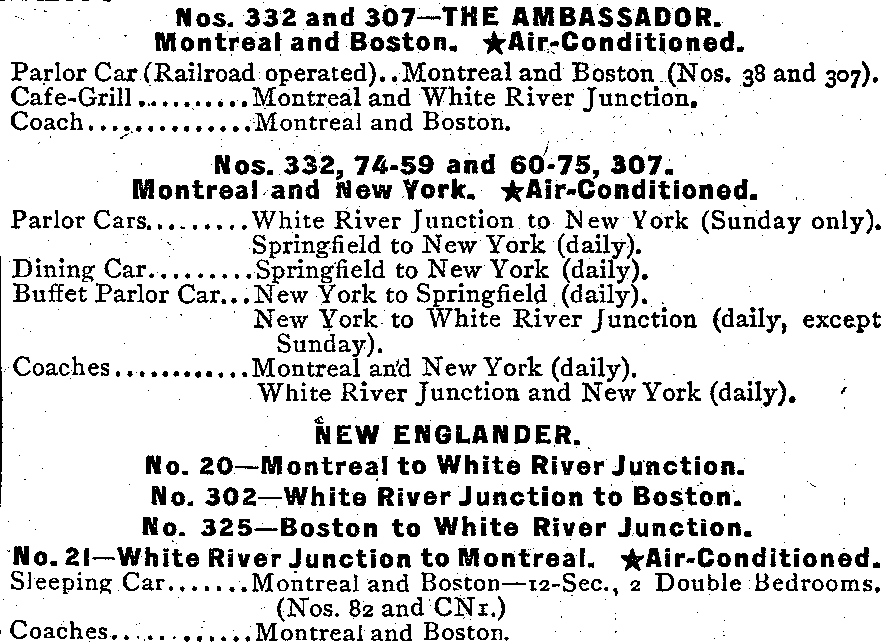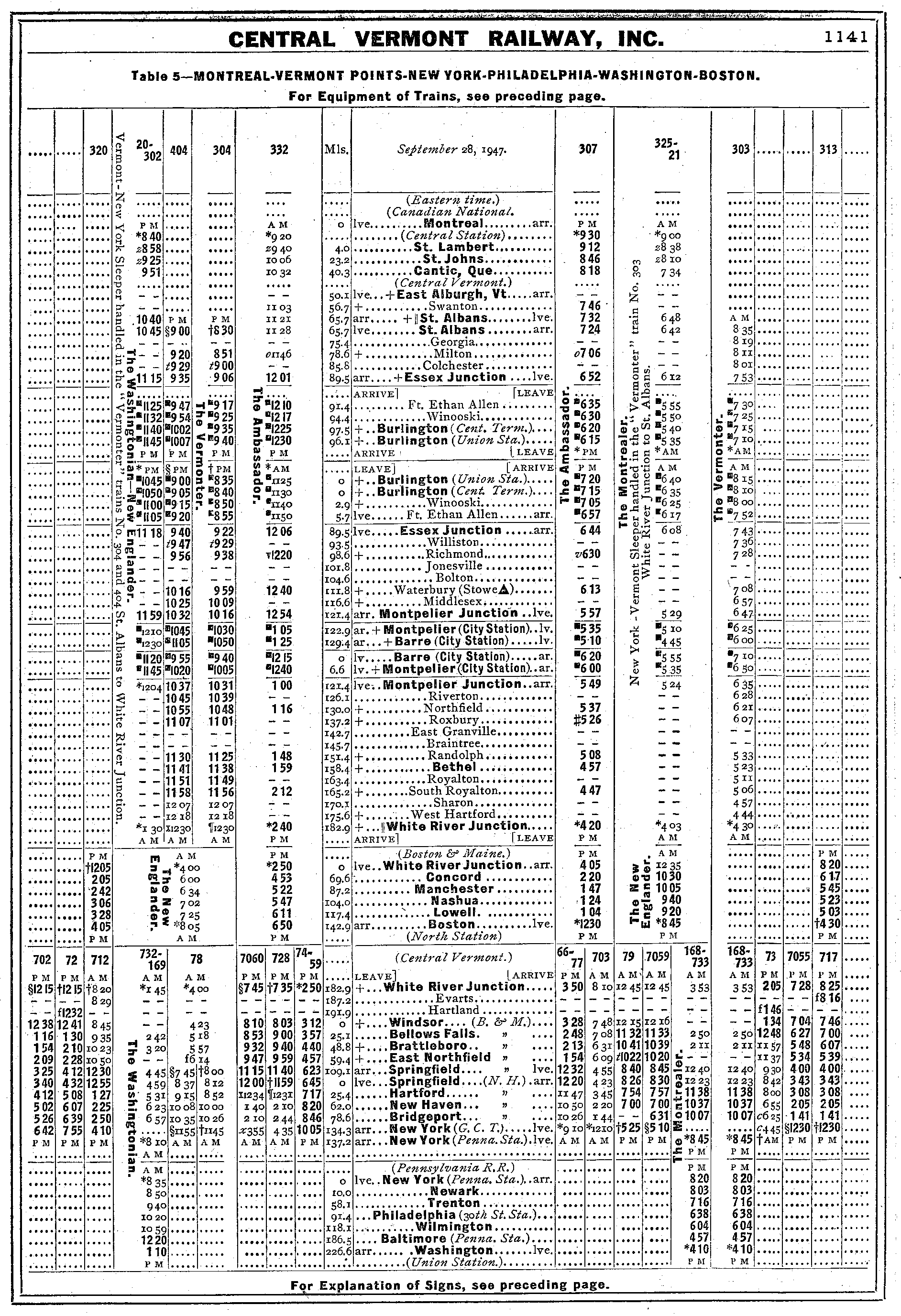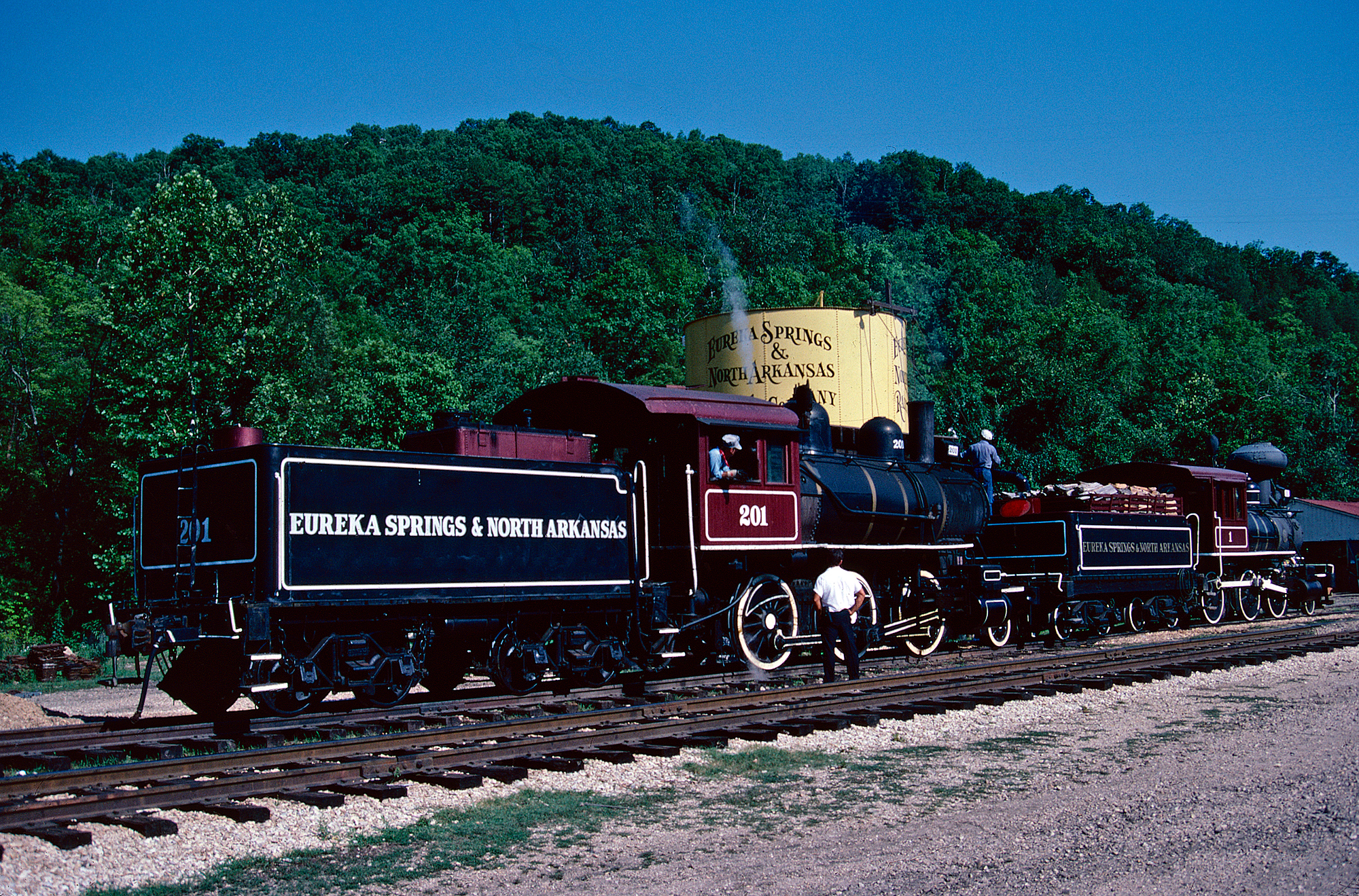The "New Englander"/"Ambassador": Boston - Montreal
Last revised: September 15, 2024
By: Adam Burns
Rail service throughout New England - and especially into southeastern Quebec, Nova Scotia, and New Brunswick - has not received a great deal of attention from literary sources.
However, carriers like the Boston & Maine, Maine Central, Central Vermont, and Bangor & Aroostook regularly worked with the Canadian lines to provide through service within this region.
The Ambassador and New Englander were named trains serving Boston and Montreal, Quebec (the former a daytime train and the latter an overnight service) operated by the Boston & Maine, Central Vermont, and Canadian National. In a long ago era, northern New England boasted a long list of trains served by multiple railroads and/or international destinations such as Montreal and Halifax.
This particular duo was first launched in the 1920s and always carried a heavyweight consist although in later years also fielded some lightweight equipment. Like its counterparts, the Ambassador/New Englander died a slow death as trains fell out of favor. What was left of both services (the Ambassador) made its final run during the late 1960s.
History
The Ambassador/New Englander spanned a corridor of just over 300 miles between Boston's North Station and Montreal's Central Station on a schedule that covered about nine hours.
According to Kevin Holland's book, "Passenger Trains Of Northern New England, In The Streamline Era," the daytime Ambassador was originally to be named the New England States Limited but this idea was ultimately scrapped. Additionally, the New Englander replaced the earlier named Bostonian on its overnight run, catering to a business clientele.
Both new trains made their inaugural runs on April 26, 1926 as heavyweight, all-steam powered affairs. During the CV leg it was quite common to see handsome Class U-1 4-8-2s leading both; these were later replaced by steam generator-equipped GP9s wearing CN's gorgeous olive green and yellow livery.
Accommodations
Before the days of airlines these trains - along with their counterparts, the Montrealer/Washingtonian - provided the fastest means possible between Montreal and the Northeast.
There were also other competing services along this corridor, such as Canadian Pacific's Red Wing/Alouette and Rutland's Mount Royal/Green Mountain Flyer.
According to Mr. Holland's book the heavyweight Ambassador ran with a diner, parlor, standard coaches, and a 25-seat, Pullman parlor-observation. The New Englander, for its part, normally ran with sleepers and coaches according to the B&M's September, 1941 timetable.
By the 1930s the Ambassador fielded its first lightweight cars from the B&M's "American Flyer" series. These were early streamlined coaches acquired between 1935-1937 from Pullman, built to specifications originally created by industrial designer Walter Teague.
Consist (1948)
Boston & Maine
Central Vermont
The B&M would end up rostering thirty examples of these cars for intercity service, which featured large windows, beveled roofs, and riveted Man-Ten/Cor-Ten steel. They offered a sleek appearance that was radically different from the traditional heavyweight cars featuring clerestory roofs and a welded construction.
In conjunction with the B&M's Flyers, CN-owned semi-streamlined coaches also began appearing on the Ambassador at around this same time.
Without question the routing of both trains was nothing short of breathtaking as passengers could enjoy all the best of New England's fabulous scenery with rolling hills and bucolic, immaculately maintained farms while skirting the Connecticut, White, and Winooski Rivers.
Ambassador Timetable (September 28, 1941)
| Read Down Time/Leave (Train #307/Boston & Maine) | Milepost | Location | Read Up Time/Arrive (Train #332/Boston & Maine) |
|---|---|---|---|
| 12:30 PM (Dp) | 0.0 | 6:30 PM (Ar) | |
| 1:05 PM | 25.6 | 5:55 PM | |
| 1:26 PM | 39.0 | 5:33 PM | |
| 1:54 PM | 55.7 | 5:07 PM | |
| 2:30 PM | 73.3 | 4:40 PM | |
| 4:00 PM (Ar) | 142.9 | 2:55 PM (Dp) | |
| Time/Leave (Central Vermont) | Milepost | Location | Time/Arrive (Central Vermont) |
| 4:18 PM (Dp) | 142.9 | 2:40 PM (Ar) | |
| 4:46 PM | 160.6 | 2:16 PM | |
| 4:57 PM | 167.4 | 2:05 PM | |
| 5:08 PM | 174.5 | 1:55 PM | |
| 5:37 PM | 195.8 | 1:26 PM | |
| 6:10 PM | 214.0 | 12:52 PM | |
| 6:40 PM | 236.3 | 12:23 PM | |
| F 7:01 PM | 247.2 | F 12:03 PM | |
| 7:20 PM | 260.1 | 11:45 AM | |
| 8:35 PM | 302.2 | 10:35 AM | |
| 9:20 PM (Ar) | 327.2 | 9:50 AM (Dp) |
New Englander Timetable (September 28, 1941)
| Read Down Time/Leave (Train #325/Boston & Maine) | Milepost | Location | Read Up Time/Arrive (Train #302/Boston & Maine) |
|---|---|---|---|
| 8:45 PM (Dp) | 0.0 | 8:03 AM (Ar) | |
| 9:23 PM | 25.6 | 7:28 AM | |
| 9:45 PM | 39.0 | 7:05 AM | |
| 10:12 PM | 55.7 | 6:32 AM | |
| 10:48 PM | 73.3 | 5:59 AM | |
| 12:50 AM (Ar) | 142.9 | 4:00 AM (Dp) | |
| Time/Leave (Central Vermont) | Milepost | Location | Time/Arrive (Central Vermont) |
| 3:55 AM (Dp) | 142.9 | 1:50 AM (Ar) | |
| 5:58 AM | 236.3 | 11:41 PM | |
| 6:28 AM | 260.1 | 11:08 PM | |
| 7:39 AM | 302.2 | 10:01 PM | |
| 8:25 AM (Ar) | 327.2 | 9:15 PM (Dp) |
By the mid-1950s the Boston & Maine had combined the Ambassador and CP's Alouette south of White River Junction creating one, large train.
The consist was nevertheless impressive which included several head-end mail express cars (two RPOs, an express car, and combine), an "American Flyer" coach, buffet-parlor, CN coach, coach-smoker (White River-Boston only), and a pair of Plymouth cars which joined the train at Concord, New Hampshire.
By this time diesels were in full control and the CV opted for GP9s, as previously mentioned, while the B&M chose the interesting, and rare, F2.
Timetable (1948)
Boston & Maine
Central Vermont
Final Years
Sadly, this was the dying era of passenger service, especially at the Boston & Maine. New management under Patrick McGinnis began implementing significant cost-cutting measures, reducing on-board amenities and accommodations.
While RDCs never appeared on the Ambassador it operated as little more than a coach-only consist after losing its café-grill during January of 1958. After 1960 the only remaining intercity, traditionally-equipped trains on the B&M were the Ambassador and joint Montrealer/Washingtonian.
Both trains said their final goodbyes over the course of the September 3rd and 4th weekend, 1966 with the former making its final run that Saturday traveling northbound to Montreal.
Sources
- Holland, Kevin J. Passenger Trains Of Northern New England, In The Streamline Era. Lynchburg: TLC Publishing, 2004.
- Schafer, Mike. Classic American Railroads. Osceola: MBI Publishing, 1996.
Recent Articles
-
Arizona Railroad Museums: A Complete Guide
Apr 16, 25 01:17 PM
Learn about Arizona's rich history with railroads at one of several museums scattered throughout the state. More information about these organizations may be found here. -
Arkansas Railroad Museums: A Complete Guide
Apr 16, 25 12:59 PM
The state of Arkansas is home to a handful of small railroad museums. Learn more about these organizations here. -
Alabama Railroad Museums: A Complete Guide
Apr 16, 25 12:30 PM
Alabama, with its storied past and vibrant connection to the railroad industry, is home to several captivating railroad museums.





